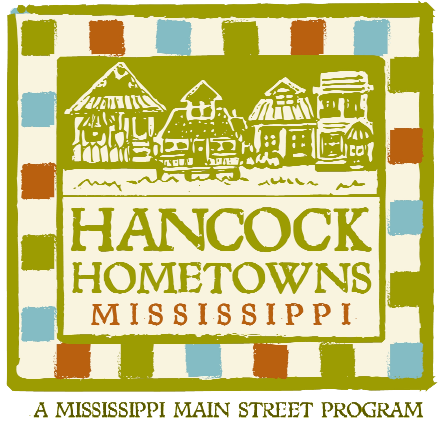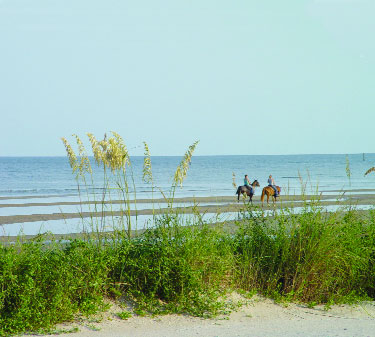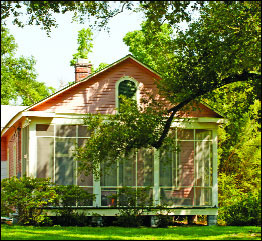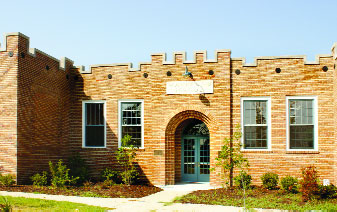Put on your walking shoes or wheel around town for a self-guided tour
of our truly amazing history in Bay St. Louis, Mississippi.
Click here for the background photo.
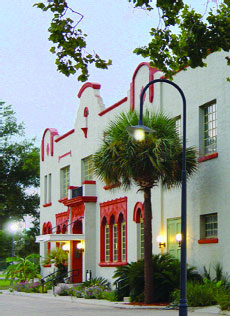
The Bay St. Louis motto is as unique as the city itself: “A Place Apart.” It speaks of an appreciation of diversity and a unique heritage that residents treasure. For over three centuries, Bay St. Louis has been home to colorful characters, fanciful buildings, and an unquenchable community spirit.
The original settlement was established in 1699 by the French explorers d’Iberville and Bienville. Known for years simply as “the Bay of St. Louis,” in the early 1800’s it officially took on the name of Shieldsboro, after a ship’s purser named Thomas Shields. Shields resided in the town and often delivered mail on his return from voyages.
The incorporation of the city under the name of Bay St. Louis was the first act of the new Mississippi legislature in 1818. It was slated to be the state capital, but in a suspenseful last minute vote, was beat out by Natchez – which soon lost the title to Jackson.
The Historic Depot on Union Street (right)
However, citizens here never lost that capital city attitude and through the centuries, Bay St. Louis grew into a center for arts, recreation and a bon vivant lifestyle. Visitors are frequently smitten after a short stay and often become residents. And most residents declare they’d live nowhere else on earth.
We invite you to meander through our streets and absorb some of our authentic Southern character. We think you’ll wind up understanding why Bay St. Louis is truly A Place Apart.
While we encourage exploring our public treasures here, please respect the privacy of our residential listings.
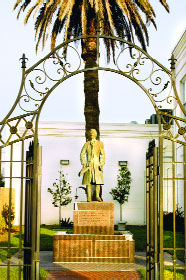
1. TERCENTENARY PARK refer to map
102 South Beach Boulevard
With an elevation of 31 feet, this park is located on the point of highest elevation on the Gulf of Mexico. A life-sized bronze statue commemorates the French explorer Bienville, who sailed into the Bay of St. Louis over 300 years ago. A granite marker on the site also honors Bay St. Louis benefactor Bill Eastburn, a Pennsylvania native whose volunteerism here post-storm led to an honorary citizenship.
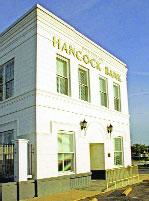
2. HANCOCK BANK BUILDING refer to map
100 South Beach Boulevard
This Hancock County bank opened for business in 1899, boasting total assets of $18,277. The corporation now has 164 offices in four states, still maintaining this original branch. The stately masonry building has been completely restored and features a flat parapet roofline and raised corbels as wall supports. It is the oldest surviving two-story building in the city.
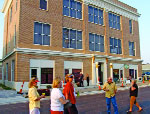
3. THE MASONIC TEMPLE BUILDING refer to map
125 Main Street
This Neo-Classical Revival style building was constructed in 1925 by A.L.Stokoe, a local bottling and lighting magnate. Stokoe also installed the first streetlights in Bay St. Louis — which turned out to be quite a controversial undertaking. Many citizens considered the lights unsightly and a lawsuit was filed to prevent the project.
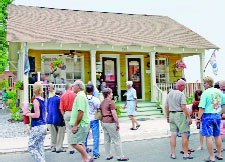
4. THE ANGELONE HOUSE refer to map
136 Main Street
Built circa 1890’s, this Bungalow style cottage has been home to several families through the decades, including the Angelone family – Sicilian immigrants. The cottage features a gabled roof with an undercut gallery and 4-bay facade. Now a retail shop, this is one of several significant historic structures on the first block of Main Street.
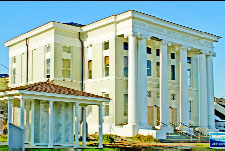
5. THE HANCOCK COUNTY COURTHOUSE refer to map
150 Main Street
This building was completed in 1911 at a cost of $25,000 with furnishings – including beds and mattresses for jurors unfortunate enough to be sequestered. The original hoosgow (jail) still exists in the southeast corner, tucked between the primary building and the new addition. The Neo-Classical Revival structure is the tallest building in Old Town and is a designated state landmark.
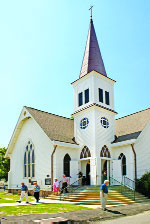
6. MAIN STREET UNITED METHODIST CHURCH refer to map
160 Main Street
This Gothic Revival house of worship was built in 1895. It’s considered to be an outstanding example of Carpenter Gothic Architecture – a style in which craftsmen of the period attempted to replicate stone carvings by using intricate woodworking techniques.
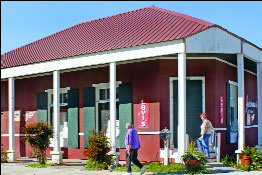
7. JEROME’S refer to map
201 Main Street
This building has housed a variety of stores for 169 years, making it one of the oldest continuously open commercial buildings on the Gulf Coast. Built in 1840, it features a canted corner entrance and a red color inspired by a turn of the century tenant, “McDonald’s Red Hots.” It’s now a retail shop.
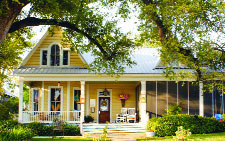
8. THE LANDMARK BUILDING refer to map
210 Main Street
Believed to be the original site of the courthouse, this building is actually comprised of two houses. A Creole Cottage and a small shotgun style house, both owned by the Mauffray family, were joined in 1900 and is now a fine dining restaurant, This block of Main Street also features a collection of turn of the century cottages, now retail shops.
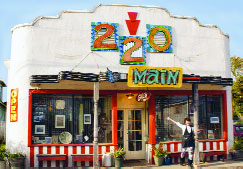
9. 220 MAIN STREET refer to map
220 Main Street
Constructed in 1929, this building adds a splash of Art Deco style to Old Town, where it served as a grocery store for many years. Currently home to an artists’ cooperative, the building is rumored to be haunted by a turn of the century spirit.
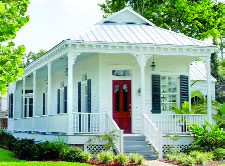
10. THE LOUIS PIERNAS HOUSE refer to map
202 South Toulme Street
Built in the 1880s, this charming side gallery cottage was home to Louis Piernas, “a free man of color.” In 1889, Piernas accepted a presidential appointment to be postmaster of Bay St. Louis, making him the first African- American postmaster in the state. Piernas also served as chairman of the Hancock County Republican Party for 65 years - traveling to Chicago in 1882 as a delegate to the National Convention. Born in 1856, he lived 98 years and is buried in the Cedar Rest Cemetery. It is now a private residence.
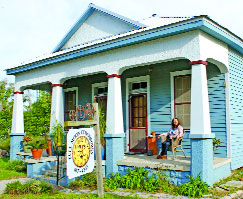
11. THE CLOCK SHOP refer to map
310 Railroad Avenue
Built in the latter part of the 1800s, this cottage was used to house railroad workers. To conserve on costs, it was constructed with a single chimney in the center of the house that served four corner fireplaces in the central rooms. This feature is the hallmark of the Biloxi Cottage, a rare design in Bay St. Louis.
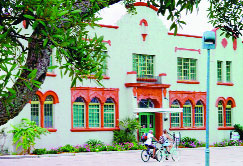
12. THE DEPOT refer to map
1929 Depot Way
This two story mission style depot was built in 1929, a fanciful addition to the heart of Bay St. Louis. Through the decades, thousands of travelers have passed through. The building served as a set in the 1965 movie starring Natalie Wood, This Property is Condemned. It is now home to the Depot Visitor Center and the Hancock County Tourism Development Bureau.
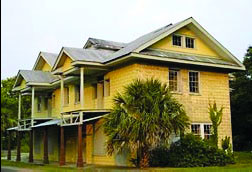
13. THIS PROPERTY IS CONDEMNED refer to map
398 Blaize Avenue
This Queen Anne style building was built in 1916 by John Scafide, a Bay St. Louis mayor. It was the centerpiece of the Sidney Pollack film from which it derives its current name. The movie, based on a play by Tennessee Williams, starred Robert Redford, Natalie Wood and Charles Bronson. Now owned by the Bay St. Louis Little Theatre, it will soon undergo a complete restoration.
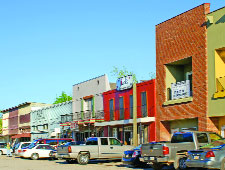
14. DEPOT ROW BUILDINGS refer to map
Blaize Avenue
The Depot District became a hub of activity with the completion of the rail line between New Orleans and Mobile in 1870. The original buildings were constructed in the railroad heyday of the late 1800s. A new addition features a cupola that gives an architectural nod to the stately Gilmore Hotel that once stood on the site. Today it boasts shops and restaurants.
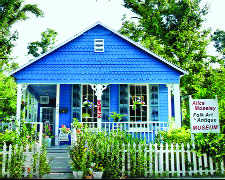
15. ALICE MOSELEY MUSEUM refer to map
214 Bookter Street
This 1915 cottage was the home and studio of nationally recognized folk artist Alice Moseley. It’s featured in one of her most famous paintings, “The House May Be Blue, But the Old Lady Ain’t.” A retired school teacher, her artistic career began at age 60. She moved to Bay St. Louis 20 years later, calling it “the end of the rainbow.” It now hosts a changing gallery of local art.
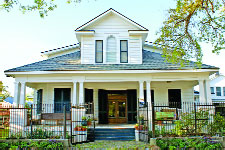
16. THE TRUST refer to map
204 Bookter Street
Circa 1850, this Colonial Revival building served as the Engman family home and mercantile establishment for several generations. Purchased from the Engman family by Hilton Eymard, the house has been completely restored. The nine bedroom bed and breakfast is furnished with a collection of antiques from the 1800s.
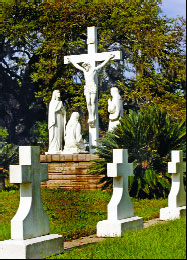
17. THE BROTHERS OF THE SACRED HEART CEMETERY refer to map
Hancock Street
St. Stanislaus College was founded by the Brothers of the Sacred Heart in 1854 and is the oldest educational institution on the Gulf Coast. In 1923, the school became a college preparatory school. The main campus fronts the beach, while this serene cemetery, located behind the school, is dedicated to the Brothers who served at the school.
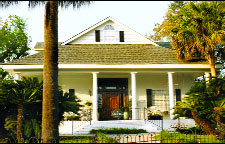
18. THE PALM HOUSE refer to map
217 Union Street
Built in the 1880s, this West Indies Planter style house was for many years the home of Joan Newman Seal. Wife of a circuit judge, Seal lived from 1848 — 1915 and became one of the city’s most well-known philanthropists. She had no children, but doted on her three dogs, even drawing up provisions for their care in her will. It is now a private residence.
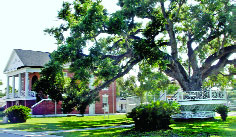
19. OLD CITY HALL & SHOOFLY OAK refer to map
Second Street & City Hall Avenue
This designated Mississippi Landmark was built in 1905 in the Georgian revival style with a front gabled portico. The “shoofly” built around the oak tree takes its name from the French word “chaufleur,” meaning “cauliflower.” The City Hall is currently being restored.
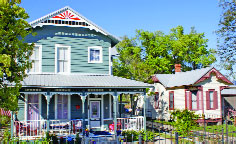
20. RAILROAD STREET HOUSES refer to map
125 – 129 Railroad Street
These three examples of Queen Anne style architecture were built around 1890 by Eugene Ray, an African-American man who was the city undertaker - as well as a contractor. The largest of the houses was the home of Bishop Leo F. Fahey, the first bishop appointed in the state of Mississippi.
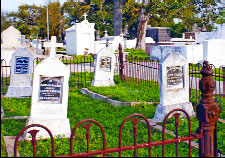
21. CEDAR REST CEMETERY refer to map
South Second Street
With graves dating from the 1820s, this cemetery has been a multi-cultural model from its inception. It serves as the final resting place of African-Americans, Caucasians, Native Americans and immigrants from far-flung countries. Each Halloween, the cemetery attracts hundreds of visitors for a unique tour where descendants of those who are buried here perform reenactments of their ancestors.
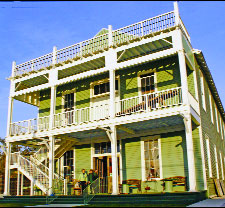
22. CENTURY HALL refer to map
112 South Second Street
Constructed in 1909 by the Woodsmen of the World society, this grand building was a Bay St. Louis entertainment center through the 1940s. Trains brought in hundreds of weekenders from New Orleans to attend hotel balls on Saturday night. After Sunday services, crowds would gather at the Hall for plays and musical performances before returning home. Today, it features art galleries and retail shops.
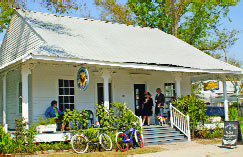
23. THE WEINBURG HOUSE & THE COBBLER’S COTTAGE refer to map
106 & 110 South Second Street
The larger of these two buildings was constructed in 1868 by John Himes for his daughter Eliza Weinburg. This rare Biloxi Cottage is the only historic house in the city that boasts a threesided gallery. Today it’s a coffee shop and art gallery. The tiny cottage at 106 South Second dates from the turn of the century and was the shop of shoemaker Manuel Maurigi for over 35 years.
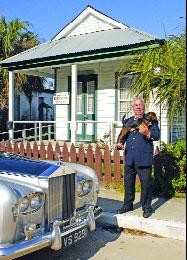
24. KATE LOBRANO HOUSE refer to map
108 Cue Street
Built in 1896, this cottage houses the extensive collections of the Hancock County Historical Society, including over 30,000 photographs. The building was donated to the Society by the Lobrano family in 1986. Originally built as a store, the shotgun style structure features a side gallery. It is open to the public and researchers.

Bay St. Louis contains many more historical jewels in addition to the sampling featured in this tour. Here are just a few of the memorable landmarks you’ll see by taking more time to explore our “Place Apart.”
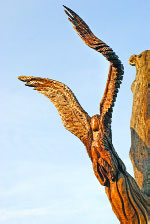 B
B 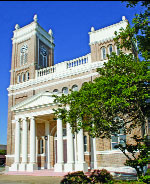 C
C 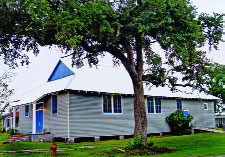 D
D 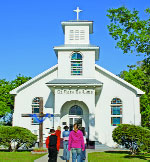
A. The Angel Tree – de Montluzin Street near Beach Boulevard
Carved angels commemorate three survivors who rode out Hurricane Katrina in this tree.
B. Our Lady of the Gulf Catholic Church – 228 South Beach Boulevard
This magnificent Romanesque church built in 1908 overlooks the Mississippi Sound.
C. 100 Men Hall – 303 Union Street
Built in 1923, for decades this recently renovated building was a musical venue for some of the South’s top performers.
D. St. Rose de Lima Catholic Church – 301 South Necaise Avenue
The “Christ in the Oak” mural behind the altar of this 1926 church is a nationally recognized work of art.
Just down the beach is our Sister City, Waveland. In the midst of rebuilding, this charming town boasts beautiful beaches with a biking and walking path, the newly restored Waveland Civic Center, the Veterans Memorial on the beach at Coleman Avenue, and the Garfield Ladner Memorial Pier, scheduled to open in the fall of 2009. Be sure to look for the Waveland Walking & Biking Tour brochure featuring both historic and fresh hot spots in this laid-back beachside village.
![]()
Don’t stop now!
You’ve just begun to sample the scenic delights of our city.
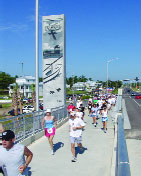
BAY OF ST. LOUIS BRIDGE
For an unbeatable vista, experience the walking and bike path on the new Bay of St. Louis Bridge. Recently winner of a national People’s Choice award for the best bridge, the path is marked at 1/10 mile intervals by bronze bas relief plaques created from work by some of our best artists. Pylons at either entrance to the bridge are enormous works of art in themselves and present fabulous photo opportunities. The unforgettable path is just over 4 miles long roundtrip with moderate inclines.
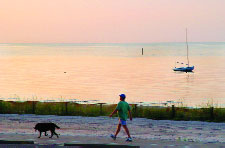
THE BAY–WAVELAND BEACH TRAIL
The Bay–Waveland Beach Trail is a flat, approximately three mile path that runs directly along the beach from the Washington Street Pier in Bay St. Louis to the Pier at Coleman Avenue in Waveland, our sister city. Take a break along the way, sit by the water’s edge and enjoy the acrobatics performed by pelicans and gulls. Birdwatchers will revel in the astonishing variety of species that can be spotted on the trail. Keep a sharp eye out near Waveland for the bald eagle that’s taken up residence in the vicinity!
Hancock Main Street • Hancock Chamber of Commerce
412 Highway 90, Suite 6 • Bay St. Louis, MS 39520
228/467-9048 • www.hancockchamber.org
